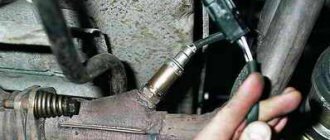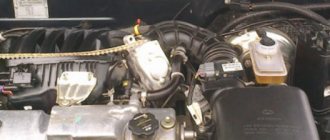A knock detection sensor (DS) in the engine cylinders was not an obvious need in the first engine control systems, and in the days of simpler principles of power management and ignition of gasoline internal combustion engines, abnormal combustion of the mixture was not monitored at all. But then the engines became more complex, the requirements for efficiency and exhaust purity increased sharply, which required an increase in the amount of control over their operation at each time.
Lean and ultra-lean mixtures, exorbitant compression ratios and other similar factors require constant work on the verge of detonation without going beyond this threshold.
What is detonation and its consequences?
Detonation is when part of the air-fuel mixture, distant from the spark plug electrodes, ignites on its own. Because of this, the flame spreads unevenly throughout the chamber and a sharp push occurs on the piston. Often this process can be recognized by a ringing metallic knock. In this case, many motorists say that their fingers are knocking.
Under normal conditions, the mixture of air and fuel compressed in the cylinder begins to ignite evenly when a spark is formed. Combustion in this case occurs at a speed of 30 m/sec. The detonation effect is uncontrollable and chaotic. At the same time, the military-technical vehicle burns out much faster. This value in some cases can reach up to 2 thousand m/s.
1) Spark plug; 2) Combustion chamber; A) Normal fuel combustion; B) Detonation combustion of gasoline.
Such excessive load negatively affects the condition of most parts of the crank mechanism (read about the structure of this mechanism separately ), valves, hydraulic compensator of each of them, etc. An engine overhaul on some models can cost as much as half an identical used car.
Detonation can damage the power unit after 6 thousand kilometers, and in some cars even earlier. This malfunction will depend on:
- Fuel quality. Most often, this effect occurs in gasoline engines when using inappropriate gasoline. If the octane number of the fuel does not meet the requirements (usually uninformed motorists buy cheaper fuel, which has a lower octane rating) specified by the engine manufacturer, then the likelihood of detonation is high. The octane number of fuel is described in detail in another review . But in short, the higher this value, the lower the probability of the formation of the effect in question.
- Power unit designs. To increase the efficiency of the internal combustion engine, engineers make adjustments to the geometry of various engine elements. During the modernization process, the compression ratio may change (it is described here ), the geometry of the combustion chamber, the location of the spark plugs, the geometry of the piston crown and other parameters.
- The condition of the engine (for example, carbon deposits on the actuators of the cylinder-piston group, worn o-rings or increased compression after a recent modernization) and its operating conditions.
- Conditions of spark plugs (read about how to determine their malfunction here ).
Why do you need a knock sensor?
As you can see, the influence of the detonation effect in the engine is too great and dangerous for the condition of the engine to be ignored. To determine whether a microexplosion occurs in a cylinder or not, a modern engine will have a corresponding sensor that reacts to such bursts and disturbances in the operation of the internal combustion engine (this is a shaped microphone that converts physical vibrations into electrical impulses). Since the electronics provide finer tuning of the power unit, only the injection engine is equipped with a knock sensor.
When detonation occurs in the engine, a load surge occurs not only on the crankshaft, but on the cylinder walls and valves. To ensure that these parts do not fail, it is necessary to adjust the optimal combustion of the fuel-air mixture. To achieve this, it is important to fulfill at least two conditions: select the correct fuel and set the ignition timing correctly. If these two conditions are met, then the power of the power unit and its efficiency will reach the maximum parameter.
The problem is that in different operating modes of the motor it is necessary to slightly change its settings. This becomes possible thanks to the presence of electronic sensors, including detonation sensors. Let's look at its device.
Voltage measurement at idle
The performance of the motor can be determined by measuring the voltage at its contacts with the engine running at idle speed. The table below shows approximate voltage values that can be used to identify a malfunction of the knock sensor.
Table - Approximate voltage values
| Voltage, V | Sensor status |
| 0-0.01 | Unusable, voltage too low |
| 0.2-4.5 | Knock meter is OK |
| Over 5 | Sensor broken, voltage too high |
Knock sensor device
On the modern automotive parts market there is a wide variety of sensors for detecting engine detonation. A classic sensor consists of:
- A housing that is fixed to the outside of the cylinder block using a bolted connection. In the classic version, the sensor looks like a small silent block (rubber bushing with a metal clip). Some types of sensors are made in the form of a bolt, inside which all the sensitive elements of the device are located.
- Contact washers located inside the housing.
- Piezoelectric sensing element.
- Electrical connector.
- Inertial substance.
- Disc spring.
1. Contact washers;
2. Inertial mass; 3. Body; 4. Belleville spring; 5. Fastening bolt; 6. Piezoceramic sensitive element; 7. Electrical connector; 8. Cylinder block; 9. Cooling jacket with antifreeze. The sensor itself in an inline 4-cylinder engine is usually installed between the 2nd and 3rd cylinders. In this case, checking the engine operating mode is more effective. Thanks to this, the operation of the unit is leveled not due to malfunctions in one boiler, but as much as possible in all cylinders. In engines with a different design, for example, a V-shaped version, the device will be located in a place where detonation is more likely to occur.











